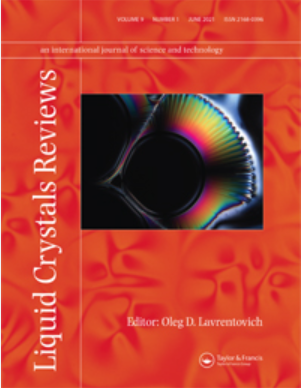Landau theory description of polar smectic structures
IF 4.2
3区 材料科学
Q2 CHEMISTRY, PHYSICAL
引用次数: 11
Abstract
In this paper we review various amazing features of polar smectic structures and phase transitions between them. In a series of experimental and theoretical studies over the last decades, a lot of new and unexpected structures have been observed and described theoretically in the realm of polar smectic liquid crystals. Not all of these structures were correctly identified experimentally and/or correctly interpreted theoretically. At least in part, the problem is in the uncertainty about which theoretical model can provide an adequate minimal description of all available experimental data. The approach we are advocating in this work is to rely on a systematic, well elaborated, and perfectly suitable to describe mean field behavior in the vicinity of phase transition lines, theoretical frame – Landau phase transitions theory. Structural and symmetry properties of the polar smectic liquid crystals require utilization of the Landau theory with the discretized over the smectic layers two-component order parameter. Furthermore, both components of the order parameter (its modulus, related to interlayer distance, and phase, related to azimuthal orientation of molecules) can be space non-uniform, describing various smectic structures. We show that this theory describes the experimentally discovered polar smectic phases and predicts a number of new structures.极性近晶结构的朗道理论描述
本文综述了极性近晶结构的各种惊人特征以及它们之间的相变。在近几十年的一系列实验和理论研究中,人们从理论上观察和描述了极性近晶液晶领域中许多新的和意想不到的结构。并非所有这些结构都能在实验上得到正确的识别和/或在理论上得到正确的解释。至少在某种程度上,问题在于不确定哪个理论模型能够为所有可用的实验数据提供足够的最小描述。我们在这项工作中提倡的方法是依靠一个系统的、精心设计的、完全适合描述相变线附近平均场行为的理论框架——朗道相变理论。极性近晶液晶的结构和对称性要求利用朗道理论,在近晶层上离散双分量序参量。此外,序参量的两个分量(与层间距离有关的模量和与分子方位有关的相位)可以是空间非均匀的,可以描述各种近晶结构。我们表明,该理论描述了实验发现的极性近晶相,并预测了一些新的结构。
本文章由计算机程序翻译,如有差异,请以英文原文为准。
求助全文
约1分钟内获得全文
求助全文
来源期刊

Liquid Crystals Reviews
CHEMISTRY, PHYSICALCRYSTALLOGRAPHY&n-CRYSTALLOGRAPHY
CiteScore
7.60
自引率
5.90%
发文量
8
期刊介绍:
Liquid Crystals Reviews publishes review articles on all aspects of liquid crystal fundamentals and applied science, including experimental and theoretical studies of physical and chemical properties, molecular design and synthesis and engineering of liquid crystal devices. The Journal fosters cross-disciplinary exchange of ideas, encouraging authors to present material at a level accessible to specialists from other fields of science and engineering. Liquid Crystals Reviews provides the scientific community, in both academia and industry, with a publication of standing, guaranteed by the Editors and by the International Editorial Board who are active scientists in the worldwide liquid crystal community.
 求助内容:
求助内容: 应助结果提醒方式:
应助结果提醒方式:


